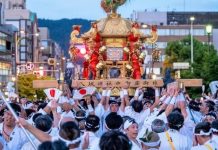Every March 17th, St. Patrick’s Day bursts forth, painting the globe green with vibrant cultural and spiritual fervor. Originally observed as a feast day honoring Saint Patrick, Ireland’s patron saint, it has now developed into a global festival of Irish spirit, culture, and tradition. This day is a time for people from all walks of life to embrace the “wearin’ o’ the green” and join in the celebrations, which include everything from pub gatherings to colorful parades, traditional Irish music, and the wearing of green and shamrocks. At The Festival Sale, we revel in the joy and unity that festivals bring, and we invite you to explore the rich history and lively traditions of this day.
Who Was Saint Patrick?
Saint Patrick, the holiday’s namesake, was a 5th-century Romano-British Christian missionary and bishop in Ireland. While the exact details of his life are subject to some debate and legend, historical accounts and his writings, such as the Confessio, provide valuable insights.

Patrick, born in Roman Britain most likely in the late 4th century, was abducted by Irish pirates and sent to Ireland as a slave. In his incarceration, he found comfort in Christianity. He finally made his way back to Britain after six years. A vision later on, nevertheless, called him to return to Ireland and preach Christianity.
Patrick’s missionary work in Ireland was remarkably successful. He traveled extensively, preaching, baptizing, and establishing churches and monasteries. He is recognized as instrumental in the Irish people’s conversion to Christianity. Folkloric accounts suggest Saint Patrick chose the humble shamrock as a powerful visual metaphor, its triple leaf becoming an instant lesson in the Holy Trinity for the people of Ireland.
Saint Patrick died on March 17th, and this date has been observed as his feast day for centuries. Over time, the religious observance evolved into a broader celebration of Irish identity and culture.
The Evolution of St. Patrick’s Day Celebrations:
What began as a Catholic feast day, St. Patrick’s Day has since become a more secular celebration of Irish heritage, embraced by people in Ireland and across the world.
- Early Observances in Ireland: The Irish celebrations for Saint Patrick were once largely religious, focused on church services and paying homage to the saint.

- The Irish Diaspora and Global Celebrations: The large-scale Irish emigration, particularly in the 18th and 19th centuries, played a significant role in spreading these day celebrations globally. Irish immigrants brought their customs to nations including Australia, Canada, the United States, and beyond.
- Parades and Public Festivities: In many of these new homelands, this day evolved to include public parades, often organized by Irish fraternal organizations and community groups. This parade evolved into a display of Irish pride and cultural identity. New York City hosted the first St. Patrick’s Day parade in American history 1762.
- The “Wearin’ o’ the Green”: Green became strongly associated with this day and Ireland. This association has roots in the green landscape of Ireland and the shamrock. On this day, wearing green is quite common.
- Secularization and Broader Participation: Over time, this day has become increasingly secularized, with people of all ethnic backgrounds joining the festivities. It’s a day to celebrate Irish culture, enjoy music and dance, and partake in the convivial atmosphere.
Key Traditions of St. Patrick’s Day:
St. Patrick’s Day is rich with traditions that are observed in various ways around the world:
- Wearing Green: This splash of emerald is arguably the most pervasive and unmistakable tradition worldwide. To demonstrate their Irish pride and to prevent being mocked for not wearing green, people dress in green, accessorize with green, and even color their hair green.
- The Shamrock: A well-known symbol of the day, the shamrock is said to have been used by Saint Patrick to preach about the Holy Trinity. Shamrock-themed décor is common, and some wear shamrock pins.

- Parades: This day, parades are a major highlight in many cities worldwide. These parades feature marching bands, floats decorated in green, Irish cultural organizations, and often local dignitaries.
- Irish Music and Dance: Traditional Irish music, with its lively reels and jigs, and Irish step dancing are integral parts of these day celebrations in pubs, cultural centers, and at public events.
- Irish Drinks and Foods: The celebration of St. Patrick’s Day often involves indulging in traditional Irish foods and beverages, with favorites like soda bread, Irish stew, and corned beef and cabbage being widely enjoyed. Irish beverages, particularly Guinness, are also a common part of the celebrations for many adults.
- “Pinching” for Not Wearing Green: On this day, it’s an amusing custom, particularly in the US, to pinch those who aren’t wearing green.
- “Kiss Me, I’m Irish” Slogans: Humorous slogans and merchandise featuring “Kiss Me, I’m Irish” are popular and contribute to the lighthearted atmosphere of the day.
- River Dyeing: In Chicago, a unique tradition involves dyeing the Chicago River green for this day, a spectacle that draws large crowds.
St. Patrick’s Day Around the World:
The celebration of St. Patrick’s Day extends far beyond Ireland:
- United States: The US has some of the largest and most elaborate celebrations on this day outside of Ireland, with major parades in cities like New York, Boston, Chicago, and Philadelphia.
- Canada: Several cities with large Irish populations, including Toronto and Montreal, host St. Patrick’s Day parades and celebrations.

- Australia: This day is celebrated across Australia with parades, Irish music festivals, and green-themed events.
- The United Kingdom: Irish populated cities around the UK celebrate and parade, in addition to Northern Ireland.
- Ireland: Celebrations in Ireland have become increasingly vibrant in recent decades, with Dublin hosting a major multi-day festival featuring parades, concerts, and cultural events.
- Other Countries: This day is also celebrated in various forms in countries worldwide, often organized by Irish expatriate communities and those who appreciate Irish culture.
The Festival Sale and the Joy of St. Patrick’s Day:
We embrace the fun, camaraderie, and appreciation of culture that so eloquently capture the essence of St. Patrick’s Day at The Festival Sale. We believe in the magic that happens when people come together to celebrate.

While we may not offer leprechaun costumes or pots of gold, we aim to foster the same excitement and connection that this vibrant holiday brings. We celebrate the desire to partake in the festive atmosphere and connect with the rich traditions of this global holiday, making it easy for everyone to share in the fun.
Celebrating St. Patrick’s Day:
There are several ways to take part in these day celebrations, regardless of whether you’re of Irish descent or just like a good party:
- Wear Green: To participate in the visual celebration, dress in your favorite green outfit.
- Attend a Parade: Check local listings for these day parades in your area.
- Enjoy Irish Music: Look for bars or events that include traditional Irish music and dancing.

- Try Irish Food and Drink: Sample some classic Irish dishes and beverages.
- Learn About Irish Culture: Take the opportunity to learn more about Irish history, literature, and traditions.
- Join a Local Celebration: Many communities host this day’s festivals and events.
- Host a Green-Themed Gathering: Invite friends and family to celebrate with Irish-inspired decorations and food.
More than just a date, St. Patrick’s Day serves as a jubilant testament to the rich tapestry of Irish culture and Saint Patrick’s immortal influence. It’s a day that brings people together in honor of heritage, community, and the simple joy of “bein’ green” for a day.





